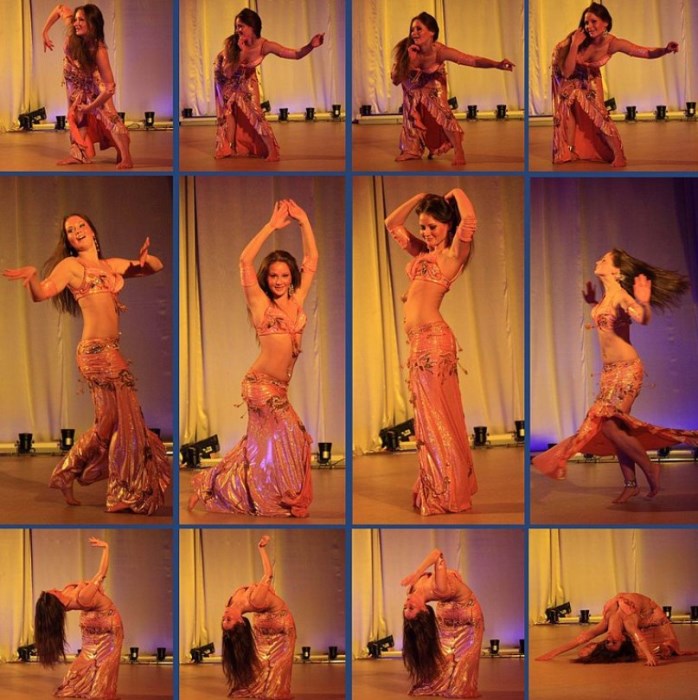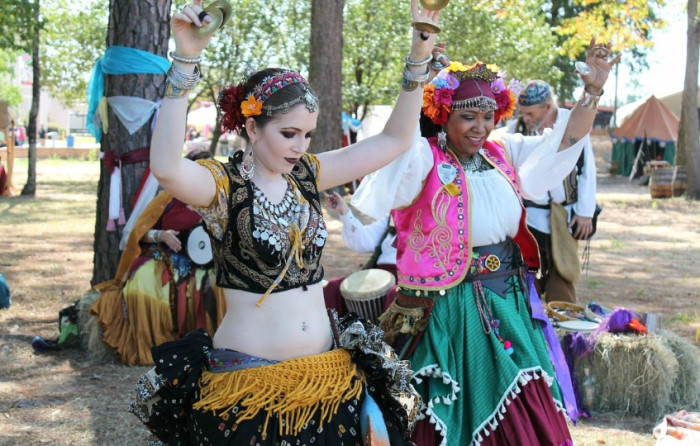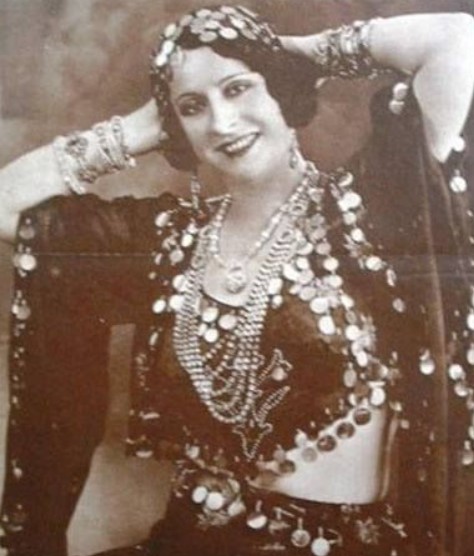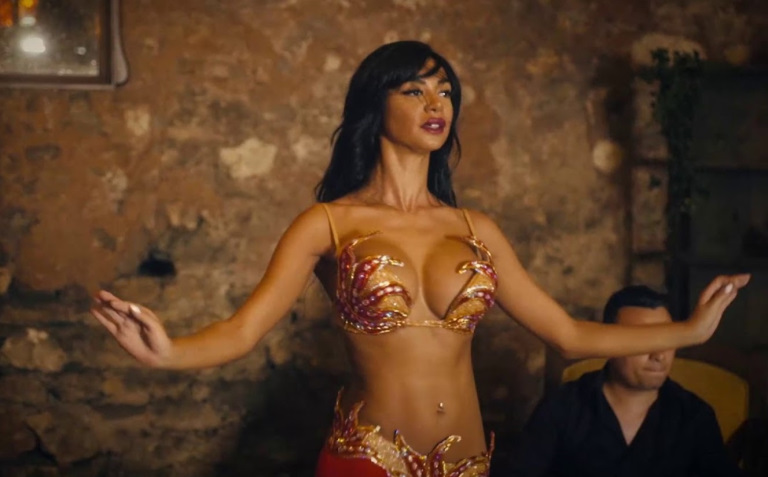Whenever someone thinks of “exotic dances,” they’d most likely think of the image of a belly dancer. With their sensuous movements, intricate rhythms, and ornate costumes, belly dancers (and belly dancing as a whole) have captivated audiences worldwide.
But belly dancing is more than just sensual lines and colorful costumes. It’s an ancient dance with a rich history dating back hundreds of years.
In this article, we’ll explore the fascinating world of belly dance, from its ancient roots to its modern-day variations. Additionally, we’ll show you some interesting tidbits about the costume, the music, a few belly dancing moves that you can try out at home, and more!
Ready? Let’s dive in!
Table of Contents
What Is Belly Dance?
Belly dance is a traditional dance form that originated in the Middle East and North Africa (Egypt, in particular.) The term “belly dance” came from the French phrase “danse du ventre” (literally meaning “belly dance”) and was written in a review piece of an Orientalist painting by the famous painter Jean-Léon Gérôme.
As its name suggests, the dance style is characterized by vigorous movements in the torso, belly, and hip areas of the dancer’s body. The dancers – who are predominantly female – make use of a variety of movements to create sensual movements that are both mesmerizing and captivating to watch.
These movements (which can include movements like shimmies, undulations, and twists) can be slow and fluid or fast and sharp, depending on the style of belly dance being performed and the music.
So, no one’s performance ever looks the same. It’s part of the reason why, hundreds of years later, belly dancing is still a widely appreciated dance form today.
Belly Dance Origin & History
Belly dance is a traditional dance form with a rich history and a diverse cultural heritage.
Belly dance in the Middle East & Africa
No historical records we’ve found can pinpoint exactly the time or the place where belly dancing was “invented.” Most just give vague references to its origin being in either the Middle East or North Africa.
Some historians believe the dance that’s now known as belly dancing came to being around 6,000 years ago in pagan societies as a way to celebrate women’s fertility.
Others believe that the dance traditions of the ancient Greeks and Romans influenced it. Still, others suggest that belly dance may have been brought to the Middle East by the gypsies or Roma people who migrated to the region from India, via the Silk Road.
Regardless of its origins, belly dance became integral to Middle Eastern and North African cultures. It’s written down in poems, countless songs have been composed for it, and many paintings and works of art have been framed after it (the most notable of which is the painting “The Dance of the Almeh” by Jean-Léon Gérôme, which ultimately gave rise to the term “belly dancing.”)
Like many folk dances, belly dancing was performed at joyous events in the community, such as weddings and festivals.
Belly dance in Eastern countries
In the late 19th and early 20th centuries, belly dance became popular in Europe and North America as part of the Orientalism movement. It was often performed in burlesque shows and other forms of entertainment. This was where belly dancing’s undeserved reputation as a “vulgar” dance came from.
The dance was spread and advertised as a shocking, sensual dance. Such was its reputation that belly dancing was banned or restricted in some Middle Eastern countries, as it was considered indecent or immoral.
However, in recent years, there has been a resurgence of interest in belly dance, both as a cultural tradition and as a form of fitness and self-expression.
Belly dancing today
Today, belly dance is performed and enjoyed by people of all ages and backgrounds around the world. It has become a popular form of exercise. Many people recognized the benefits of the vigorous body movements of the dance and incorporated them into their fitness routines.
And while it’s banned or frowned upon in many parts of the world, in many Middle Eastern and African countries, belly dancing is still considered a beloved traditional dance. It can often be seen during joyous events in the local community.
Basic Belly Dance Moves
When you first watch a belly dance performance, it may seem like the choreography is incredibly intricate, with many moves and combinations.
While belly dancing is truly a complicated dance, the basic moves that form the foundation of the dance are the same throughout all variations of the dance.
Specifically, the basic moves are separated into three groups: percussive, fluid, then shimmies, shivers, and vibrations (the three are considered a singular group.)

Percussive movements
Percussive movements are sharp, staccato movements that emphasize the beat of the music. These movements give a belly dancing performance its rhythmic, trance-like quality.
Percussive movements can include moves like hip drops, which involve dropping one hip at a time, alternating between the left and right hip.
Hip lifts are also a popular move. It’s the reverse of the hip drops and involves lifting one hip at a time, alternating between the left and right hip.
Then lastly, there are the hip twists. The moves are exactly what it said on the tin: twisting the hips in a circular motion, either to the left or right.
But note that percussive movements don’t just include the hips alone (though they’re usually performed using this area of the body.) The dancer can also use their chest and shoulder.
Fluid movements
Fluid movements are smooth and flowing movements that create a sense of grace and fluidity. These are some of the most iconic movements that are commonly thought of when someone mentions “belly dancing.”
The Figure 8s, for example, is a move that involves drawing a figure 8 with the hips, moving first to the left and then to the right in a circular motion. When performed by a trained and experienced dancer, it can be extremely mesmerizing to watch.
Undulations are another move that can create a beautiful, mind-bending movement. With the torso, the dancer will rock in a wave-like motion as if they’re painting a picture of the ocean waves using their body.
And last but not least, there are the Snake arms. The dancer will move their arms in a serpentine fashion, giving the impression of slithering snakes.
Shimmies, shivers, and vibrations
Shimmies, shivers, and vibrations are rapid, shaking movements that create a sense of energy and excitement. It also serves to lend texture and depth of movement to the performance. These moves complement the dance’s climactic or more exciting portions very well.
There are many kinds of shimmies (rocking the body to create a shimmering, rapid effect.) Depending on the style of the dance as well as the music, the shimmy can be relaxed, with a simple up-and-down motion, or ferocious with straight-legged, knee-driven motions.
Other Motions
Dancers can utilize other motions in their performance, too, such as spins, turns, level changes, etc., to create a more exciting, beautiful performance for the audience. And to add some extra flair, they can use small kicks, arabesque, and other gymnastic moves.
Belly Dance Costume
Belly dance is not just about the moves but also the costume. Other than the dance itself, it’s the most prominent part of a show.
The costumes worn in belly dance are often colorful and intricate, featuring a variety of different fabrics, textures, and designs.
A belly dancer outfit typically consists of a top, skirt, and hip scarf.
The top may be a bra-like garment or a blouse decorated with sequins, beads, and jewels. The belly dance skirt is usually long and flowing, often made of light and soft materials like chiffon or silk, and may be slit to allow for more comfortable movements.
Certain Arabian belly dancing costumes are full-fledged dresses, such as the Beledi dress (meaning “My home town” in Arabic.) It’s a long, floor-length dress that gives the dancer a very folkloric look (which is why it’s always worn for more folk-ish performances.
Headdresses may be worn to add a regal or exotic element to the performance and are often decorated with jewels, feathers, or other embellishments.
However, do note that depending on the region and style of the dance, the costumes may differ greatly. You’ll generally see a lot of differences between the costume of a Turkish belly dancer and an Egyptian belly dancer.
For example, Egyptian belly dancer costumes may feature more elaborate beading and sequins, while Turkish belly dance costumes may be more ornate and feature heavier fabrics like velvet.
You’ll love: 40+ Famous Belly Dance Quotes And Sayings
Notable Belly Dancers
Badia Masabni
While belly dancing is an art that’s been around for literal centuries, modern belly dancing has only been around since the early 20th century. And credited with its development was Badia Masabni.
Born in Lebanon in 1892, Masabni moved to Cairo, Egypt, in the early 1920s and opened a nightclub called Casino Badia. The nightclub became a hub for the performing arts, particularly, for its belly dancing shows.
There are also a lot of interesting stories about the nightclub. Other than an entertaining hub, it’s rumored to be a base of operation for spies and military members during World War II … but we’re not here to talk about that!
Masabni wasn’t simply a nightclub owner. She was also a performer. Her routines combined elements of Egyptian folk dance with the more sensual movements of the oriental variation of the dance, creating not just an exotic look but a wonderful show for the audience.
She also trained many of the most famous belly dancers of the time, including Samia Gamal and Tahia Carioca.
Nesrin Topkapı
Nesrin Topkapı (born Nesrin Gökkaya) is a renowned Turkish belly dancer. She was born in Turkey in 1951 and began dancing at a young age, starting with ballet lessons.
By the time she turned six years old, she had already appeared on stage at a casino as a young belly dancer. However, due to her young age, she was forbidden from performing at the casino later (and the place itself eventually closed down.)
Topkapı rose to fame in the 1970s and 1980s, when she became one of the most sought-after belly dancers in Turkey and was considered on par with legendary dancers at the time, like Tülay Karaca and Seher Şeniz.
Throughout her career, Topkap performed worldwide, including in the United States, Europe, and the Middle East.
Fifi Abdou
Fifi Abdou is a legendary Egyptian belly dancer, actress, and television personality. She was born in Cairo in 1953. By the time she turned 12 years old, she was already performing with a baladi (Egyptian dance) troupe and later became a model.
Abdou quickly rose to fame in the 1970s and 1980s, becoming one of Egypt’s most popular and iconic belly dancers. One performance of hers alone could net her over $10,000!
In addition to her work as a dancer, Abdou also had a successful career as an actress, appearing in numerous Egyptian films and television shows.
Throughout her career, Abdou has been a controversial figure, with some criticizing her for being too provocative and others celebrating her as a trailblazer in the world of belly dance.
Since Egypt is a predominantly Islamic country, her dance was considered “depraved” by many of her fellow countrymen. On one occasion, she was sentenced to three months in jail for her dances.
Regardless of these opinions, her impact on belly dancing and the Egyptian culture as a whole can’t be denied!
Didem
Didem (full name Didem Kınalı) is a Turkish belly dancer who was born in 1985 in Istanbul. She began dancing at a young age and quickly gained recognition for her talent.
Some of her best performances have been broadcast on Turkish national television, on shows such as the İbo Show, hosted by İbrahim Tatlıses.
Check more: Top 10 Famous Belly Dancers In The World
Belly Dance Music
Let’s talk about the music!
The dance is intimately connected to music; the two art forms have evolved together for centuries.
Historically, belly dance music was played live, often by a small ensemble of musicians consisting of a percussionist, a wind instrument player, and a stringed instrument player.
Today, many belly dance shows (especially the lower-budget ones) don’t use a live band. Rather, they’d use recorded music. Live bands are still popular for bigger shows, however.
Belly dance music is often divided into two main categories: Baladi and sharqi.
Baladi music is more folkloric and often features slower rhythms. Meanwhile, sharqi music is more contemporary and features faster rhythms. You’ll also hear a wider range of instruments in sharqi music.
Final Words
Belly dance is a fascinating and dynamic dance form that has evolved for centuries. We hope this deep-dive article has given you a better sense of appreciation for this ancient, wonderful dance form that is a celebration of movement, culture, and artistry.
Have you ever seen a belly dancing show? What was your experience like?
We’d love to hear your thoughts and experiences in the comment section below!





